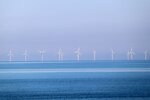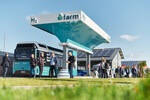03/02/2009
Special Edition: World Wind Energy Report 2008 (Part 4)
This is part four in the series "Special Edition: World Wind Energy Report 2008" published by the World Wind Energy Association.
Continental distribution:
In terms of continental distribution, a continuous diversification process can be watched as well: In general, the focus of the wind sector moves away from Europe to Asia and North America. Europe decreased its share in total installed capacity from 65,5 % in 2006 to 61 % in the year 2007 further down to 54,6 % in 2008.
Only four years ago Europe dominated the world market with 70,7 % of the new capacity. In 2008 the continent lost this position and, for the first time, Europe (32,8 %), North America (32,6 %) and Asia (31,5 %) account for almost similar shares in new capacity. However, Europe is still the strongest continent while North America and Asia are increasing rapidly their shares.
The countries in Latin America and Africa counted for respectively only 0,6 % and 0,5 % of the total capacity and fell back in terms of new installations down to respectively only 0,4 % and 0,3 % of the additional capacity installed worldwide in the year 2008.
Africa:
In spite of the huge potentials all over the continent, with world’s best sites in the North and South of the continent, wind energy plays still a marginal role on the continent with 563 MW of total capacity.
Several major wind farms can be found in some of the North African countries like Morocco, Egypt or Tunisia. In the year 2009 and 2010, substantial increases can be expected from projects which are already in the development stage. However, so far, the emergence of domestic wind industry in African countries is only in a very early stage and donour organisations should put a special focus on the creation of markets which enable industries to emerge. However, it is interesting to see that companies from the region are showing an increasing interest and have started investing in the wind sector.
In Sub-Saharan Africa, the installation of the first wind farm in South Africa operated by an Independent Power Producer can be seen as a major breakthrough. The South African government prepares the introduction of a feed-in tariff which would create a real market, enable independent operators to invest and thus play a key role in tackling the country’s power crisis.
In the mid-term, small, decentralised and stand-alone wind energy systems, in combination with other renewable energies, will be key technologies in rural electrification of huge parts of so far unserved areas of Africa. This process has only started at very few places and the main limiting factor is lack of access to know-how as well as financial resources.
Asia:
with the two leading wind countries China and India and 24’439 MW of installed capacity – is in a position of becoming the worldwide locomotive for the wind industry. China has again doubled its installations and Chinese domestic wind turbine manufacturers have started for the first time to export their products. It can be expected that in the foreseeable future Chinese and Indian wind turbine manufacturers will be among the international top suppliers.
The Indian market has shown robust and stable growth in the year 2008. It has already a well-established wind industry which already plays a significant and increasing role on the world markets.
Further countries like South Korea (already with 45 % growth rate in 2008) start investing on a larger scale in wind energy and it can be observed that more and more companies are developing wind turbines and installing first prototypes. In parallel with the market growth in the country, it can be expected that also new manufacturers will be able to establish themselves. The World Wind Energy Conference held on Jeju island in June 2009 is expected to push the development in the region. Pakistan installed its first wind farm in the year 2008 and the Government of the country aims at further wind farms in the near future.
Dont miss part five in this series. For more information please contact Trevor Sievet at ts@windfair.net
Continental distribution:
In terms of continental distribution, a continuous diversification process can be watched as well: In general, the focus of the wind sector moves away from Europe to Asia and North America. Europe decreased its share in total installed capacity from 65,5 % in 2006 to 61 % in the year 2007 further down to 54,6 % in 2008.
Only four years ago Europe dominated the world market with 70,7 % of the new capacity. In 2008 the continent lost this position and, for the first time, Europe (32,8 %), North America (32,6 %) and Asia (31,5 %) account for almost similar shares in new capacity. However, Europe is still the strongest continent while North America and Asia are increasing rapidly their shares.
The countries in Latin America and Africa counted for respectively only 0,6 % and 0,5 % of the total capacity and fell back in terms of new installations down to respectively only 0,4 % and 0,3 % of the additional capacity installed worldwide in the year 2008.
Africa:
In spite of the huge potentials all over the continent, with world’s best sites in the North and South of the continent, wind energy plays still a marginal role on the continent with 563 MW of total capacity.
Several major wind farms can be found in some of the North African countries like Morocco, Egypt or Tunisia. In the year 2009 and 2010, substantial increases can be expected from projects which are already in the development stage. However, so far, the emergence of domestic wind industry in African countries is only in a very early stage and donour organisations should put a special focus on the creation of markets which enable industries to emerge. However, it is interesting to see that companies from the region are showing an increasing interest and have started investing in the wind sector.
In Sub-Saharan Africa, the installation of the first wind farm in South Africa operated by an Independent Power Producer can be seen as a major breakthrough. The South African government prepares the introduction of a feed-in tariff which would create a real market, enable independent operators to invest and thus play a key role in tackling the country’s power crisis.
In the mid-term, small, decentralised and stand-alone wind energy systems, in combination with other renewable energies, will be key technologies in rural electrification of huge parts of so far unserved areas of Africa. This process has only started at very few places and the main limiting factor is lack of access to know-how as well as financial resources.
Asia:
with the two leading wind countries China and India and 24’439 MW of installed capacity – is in a position of becoming the worldwide locomotive for the wind industry. China has again doubled its installations and Chinese domestic wind turbine manufacturers have started for the first time to export their products. It can be expected that in the foreseeable future Chinese and Indian wind turbine manufacturers will be among the international top suppliers.
The Indian market has shown robust and stable growth in the year 2008. It has already a well-established wind industry which already plays a significant and increasing role on the world markets.
Further countries like South Korea (already with 45 % growth rate in 2008) start investing on a larger scale in wind energy and it can be observed that more and more companies are developing wind turbines and installing first prototypes. In parallel with the market growth in the country, it can be expected that also new manufacturers will be able to establish themselves. The World Wind Energy Conference held on Jeju island in June 2009 is expected to push the development in the region. Pakistan installed its first wind farm in the year 2008 and the Government of the country aims at further wind farms in the near future.
Dont miss part five in this series. For more information please contact Trevor Sievet at ts@windfair.net
- Source:
- World Wind Energy Association
- Author:
- Edited by Trevor Sievert, Online Editorial Journalist / Author: WWEA Staff
- Email:
- ts@windfair.net
- Link:
- www.windfair.net/...
- Keywords:
- wind energy, wind farm, renewable energy, wind power, wind turbine, rotorblade, offshore, onshore









